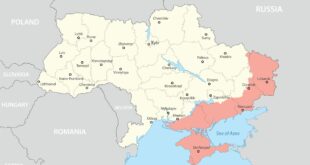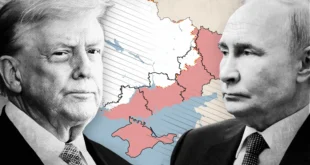So far, the conflict has remained within manageable bounds for the international community, but the prospect of further conflagration is not far off.
Oleksiy Danilov, secretary of Ukraine’s National Security and Defense Council, recently warned attendees at the Kiev Security Forum that “World War III is already underway.” He may be onto something.
The war between Russia and Ukraine began on February 24, 2022. In the first few weeks, it seemed as if the Russians would crush the Ukrainians in a blitzkrieg-style offensive. That prediction was wildly inaccurate. The Russian army was ill-prepared for the mission, and its equipment was far less effective than expected. To say that the morale of its soldiers was not high is an understatement.
By late Spring 2022, the Washington Blob was once again wildly off-base, with experts predicting that Russia would capitulate under the Western sanctions. Those expecting a calamity for the Russian economy learned nothing from Western sanctions on North Korea and Iran—two countries much smaller than Russia that have endured severe sanctions over many years. The sanctions undeniably damaged their economies but didn’t change the fundamental nature of the regimes.
Today, Russia and Ukraine appear locked in a “foxhole” war, similar to World War I, where both sides suffered massive casualties without significant territorial or strategic gains. It seems increasingly likely that this stalemate may last for years. There are several reasons to believe this could be the case.
Neither Russia nor Ukraine appears to have the military capability to defeat the other side. At the same time, neither Vladimir Putin nor Volodymyr Zelensky can quit. If Zelensky throws in the towel, his country will no longer be free, and he will likely fall from power. If Putin quits, he will demolish his image as Russia’s strongman and face challenges to his rule.
Some journalists have predicted that the war’s unpopularity, owing to the high casualty count, coupled with the heavy toll of the sanctions, could turn the Russian people against Putin. This, too, is wildly off-base. Russian history is replete with leaders who imposed enormous losses on the population without paying the price of regime collapse. Major strategic miscalculations by Joseph Stalin and his top brass led to humiliating military defeats to the invading Nazi army throughout Operation Barbarossa in 1941. The Soviets lost vast territory, and their casualties numbered in the millions even before the notoriously bloody Battle of Stalingrad commenced. As Russians still boast today, the hardship steeled the resolve of the Russian army and people, leading to a historic victory over the German invaders.
Of course, none of this means the world is marching toward a total war. But key scenarios still could precipitate a turn for the worst. For example, a collapse of the Russian frontlines (e.g., Ukrainian troops breaking through Zaporizhia, Kherson, and surrounding areas and establishing a significant bridgehead on the Crimea peninsula) could prompt Russia to deploy nuclear weapons (tactical or strategic) to restore the balance. Deputy Chairman of Russia’s National Security Council Dmitry Medvedev has repeatedly warned that Russia won’t hesitate to use such weapons if necessary. Similarly, a sudden Ukrainian collapse—leading to the fall of Kiev—may cause the United States and its NATO allies to introduce new, more destructive weapons or even deploy “boots on the ground” to restore the balance. In either scenario, the road to WWIII is not only a scenario for science fiction.
More broadly, a miscalculation by either party could have unintended consequences. For example, a Russian anti-aircraft battery downing a NATO jet fighter crossing from Polish airspace into Ukraine due to a navigational error could push NATO to invoke Article 5. Similarly, if Russian long-range missiles accidentally strike a target in one of Ukraine’s NATO neighbors, causing significant fatalities, Article 5 invocation, again, is not out of the question.
Should another nation-state join the war, it could spark a wider war. During the last eighteen months, thousands of foreign fighters have joined both sides. The situation is reminiscent of the international brigades that fought for the Nationalists and the Republicans in the Spanish Civil War (1936–1939). But, as the stalemate persists on the front lines, we may see other nations step in. Belarus, where President Lukashenko has sided with the Russians from the start, is an obvious candidate. Another candidate is North Korea. Supreme Leader Kim Jong Un recently replenished Russian stores of weapons and ammunition from his own arsenals. Kim will likely shed no tears if North Korean troops die in Ukraine, gaining him a more significant role on the world stage.
On the other side of the ledger, it remains unlikely that Western countries like Britain, Germany, or France would dispatch troops to Ukraine. But given the deep historical enmity and suspicion that some Eastern European nations, like Poland, harbor toward Russia, who knows what could happen?
So far, China has attempted to convey a policy of neutrality, even as Beijing helps Moscow behind the scenes. China understands that its current economic crisis is partially related to deteriorating relations with the United States. However, conflict may not be a deterrent for Beijing. The Chinese leadership is actively weighing a war of conquest or forced integration of Taiwan. President Xi Jinping could, at some point, offer the Russians a deal whereby they would back his invasion of Taiwan in exchange for Chinese support against the United States and Europe. While some might dismiss this, it is instructive to remember that the People’s Liberation Army (the largest in the world) is about to enter the fifth and final year of its major modernization plan. If the war between Russia and Ukraine is still raging in 2025, such a scenario may be more realistic.
Thankfully, there are also good news scenarios that could end the conflict and, therefore, the diminished likelihood of a global conflict. In a sense, Ukraine and Russia have proven their ability to maintain some sort of ceasefire by avoiding an all-out war after the Russian invasion of Crimea in 2014. Relative calm endured through 2022. It wasn’t a complete ceasefire, as regular skirmishes continued in the Donetsk and Luhansk regions (where most of the population are ethnic Russians). Still, it was kept (more or less) under control. Thus, both sides might agree to a ceasefire if it means not accepting defeat.
One significant wildcard is former president Donald Trump. If Trump returns to the White House next year, he will likely uphold his promise and cut all aid to Ukraine. He could even apply pressure on his NATO allies to stop their support. In such a scenario, the Ukrainians may reluctantly agree to a ceasefire under disadvantageous conditions.
While the chances for the war in Ukraine to evolve into a global conflict are not high, they are not nil either. Tensions are high, and European nations are increasing their defense spending. The fear of wider Russian aggression has many of these countries on edge. They understand that as the war drags on, as the casualties mount, and the sanctions pressure grows, the “wounded bear” can become even more dangerous and potentially more prone to miscalculation.
Brigadier General (res.) Jacob Nagel is a senior fellow at the Foundation for Defense of Democracies (FDD) and a visiting professor at the Technion. He previously served as Prime Minister Netanyahu’s national security advisor and the head of Israel National Security Council (acting).
Lt. Colonel (res.) Boaz Golany is a Professor at the Technion, Israel Institute of Technology, where he has served as a Dean, VP for External Relations & Resource Development, and Executive VP & Director General. His research interests cover diverse areas of applied operations research. He has also served as a board member and consultant to various companies and organizations.
 Geostrategic Media Political Commentary, Analysis, Security, Defense
Geostrategic Media Political Commentary, Analysis, Security, Defense





